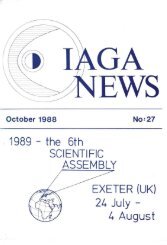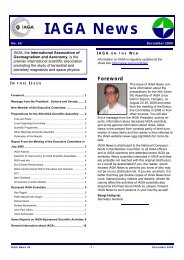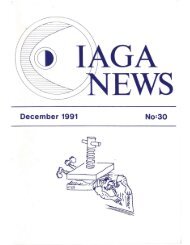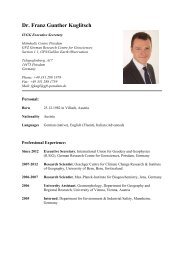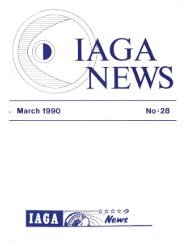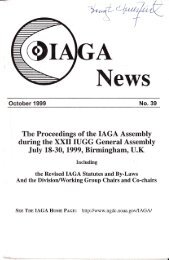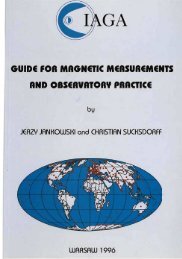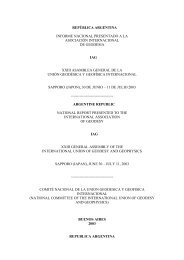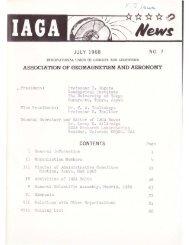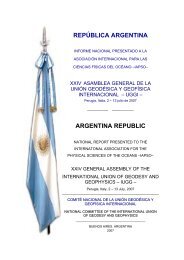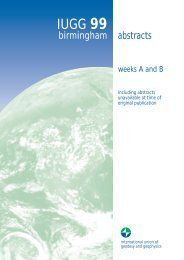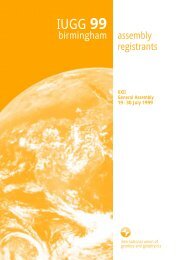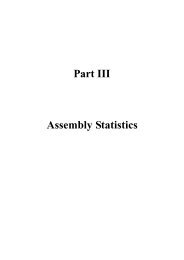IAGA News 2011 - IUGG
IAGA News 2011 - IUGG
IAGA News 2011 - IUGG
Create successful ePaper yourself
Turn your PDF publications into a flip-book with our unique Google optimized e-Paper software.
at the Physical Research Laboratory, Ahmedabad during<br />
1972-73, before moving to the Indian Institute of Geomagnetism<br />
(IIG) where he spent the rest of his career.<br />
He was the Director of IIG from 1991 until his retirement<br />
in 1997.<br />
Bhisham Singh was instrumental in starting ‘Solid Earth<br />
Geomagnetism’ as a distinct division at IIG. The geomagnetic<br />
depth sounding studies he initiated in India in the<br />
1970sincollaborationwithDr. F.E.M.LilleyofAustralian<br />
National University and Dr. B. J. Srivastava of the National<br />
Geophysical Research Institute in India led to the<br />
generation of a sub-surface electrical conductivity map for<br />
India. Magnetotelluric and Ocean Bottom Magnetometer<br />
researchatIIGwerealsointroducedbyhim. Heplayedthe<br />
leading role in the development at IIG of research using<br />
MAGSAT data.<br />
He will be remembered for his valuable contributions to<br />
the growth of IIG. He published more than 125 papers in<br />
internationalandnationaljournals, andprovidedguidance<br />
to several students in their Ph.D. degree work. During his<br />
tenure as Director, IIG had extensive scientific collaboration<br />
with IZMIRAN. He was elected a Fellow of the<br />
National Academy of Sciences, India; Indian Geophysical<br />
Union, Association of Exploration Geophysicists, and Geological<br />
Society of India.<br />
He also played an active role in the National and International<br />
scientific community. He was the National<br />
correspondent of India for <strong>IAGA</strong>. He was elected Vice-<br />
Chairman, Division I (Internal fields) of <strong>IAGA</strong> for the<br />
period 1987-1991, and during this period he was also a<br />
member of Working Group (I-3) of <strong>IAGA</strong> on Electromagnetic<br />
Induction in Earth and Moon. He served as a member<br />
of the Executive Council, Indian Geophysical Union;<br />
Member-Secretary, National committee of the Indian National<br />
Science Academy for <strong>IUGG</strong>; and Member, Mining<br />
Geological and Metallurgical Institute of India, Mumbai.<br />
He was also a member of the sub-committee on Marine<br />
Geology for the Geological Survey of India, and a member<br />
of the National coordination committee for Antarctic<br />
programs of the Department of Ocean Development, of<br />
the Government of India.<br />
Bhisham Singh was always a helpful colleague and mentor.<br />
He encouraged students and younger faculty members<br />
to strive for excellence in their research. He expired<br />
on February 19, <strong>2011</strong> after a prolonged illness. His passing<br />
is a great loss to the geosciences community in India,<br />
and in particular for those scientists who work in the area<br />
of geo-electromagnetism.<br />
G. Gupta and A. Bhattacharyya<br />
Indian Institute of Geomagnetism, Navi Mumbai, India<br />
Ingrid Sandahl (1950 - <strong>2011</strong>)<br />
Ingrid Sandahl passed away on 5 May <strong>2011</strong>. She was 61<br />
years old. This is a great loss not only for her family and<br />
friends but also for our field of research. Ingrid was an<br />
active scientist at the Swedish Institute of Space Physics,<br />
IRF, until just a few days before cancer ended her life.<br />
Ingrid became the first female scientist at IRF in 1975 after<br />
having spent one and a half years working with Arctic<br />
research in Canada. She was an enthusiastic person in<br />
our field of science and had a large network of international<br />
friends. Ingrid was heavily involved in collaborative<br />
projects and was a visiting scientist at the Geophysical<br />
Institute, University of Alaska, Fairbanks, in 1989, at the<br />
Institute of Space and Astronautical Science, Japan, in<br />
1996/1997 and a visiting professor at the National Institute<br />
of Polar Research, Japan, in 2007. She was made<br />
a member of several societies, e.g., the Royal Swedish<br />
Academy of Science in 1998, and acted as <strong>IAGA</strong> National<br />
Correspondent. She became Professor of Space Physics<br />
at IRF and Ume˚a University in 1999.<br />
Auroral physics was always a major field of interest for<br />
Ingrid. She started working at IRF with sounding rocket<br />
experiments and charged particle instrument development<br />
and testing. She also spent several years working with<br />
magnetospheric physics and satellite instruments. Auroral<br />
phenomena using ground-based observations were her<br />
major research interest in recent years. She was head<br />
of one of the research programmes at IRF and had been<br />
responsible for its observatory programme since 2010. Ingrid<br />
had a deep engagement in coordinating the Nordic<br />
optical network. Her scientific contributions consisted not<br />
only of academic papers about auroral particle acceleration,<br />
auroral morphology and solar-terrestrial relationships<br />
– she also had a great interest in auroral science history,<br />
andmademanyappreciatedpresentationstostudentsand<br />
the general public as well as to the press and other media.<br />
Ingrid was an excellent host, taking good care of visitors<br />
in Kiruna. Many friends and colleagues will remember the<br />
pleasant evenings spent in her home, planning for future<br />
projects or just having a good time.<br />
Lars Eliasson<br />
Swedish Institute of Space Physics, Kiruna, Sweden<br />
5 General information about <strong>IAGA</strong><br />
5.1 <strong>IAGA</strong> books series published by<br />
Springer<br />
One of the most important achievements of <strong>IAGA</strong> during<br />
the last two years was to publish, with Springer, a<br />
series of five books, representing results obtained by the<br />
<strong>IAGA</strong> five divisions over recent years. As well as providing<br />
useful reference texts, the income to <strong>IAGA</strong> from<br />
Springer for this venture was used to support scientists<br />
to attend the last SA in Sopron, Hungary. The previous<br />
Secretary-General devoted considerable time and effort to<br />
seeing this project through to completiong, and the current<br />
Secretary-General would like to thank warmly everyone<br />
who showed support during the preparation of these<br />
manuscripts, and is grateful for the time taken by colleagues<br />
and friends to provide valuable information and<br />
data, comments and encouragement, as authors, editors<br />
or referees.<br />
<strong>IAGA</strong> <strong>News</strong> <strong>2011</strong> – Page 12



